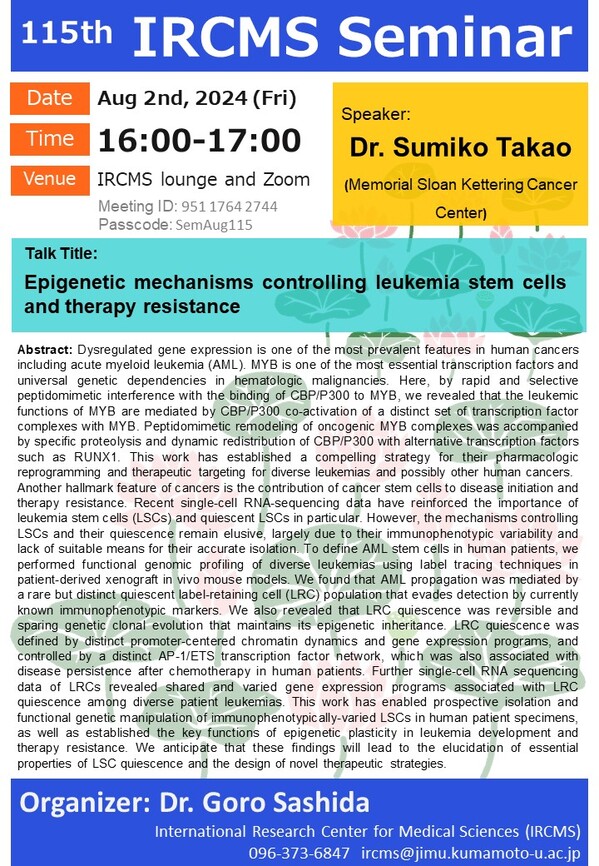- HOME
- News & Events
- [Aug. 2] 115th IRCMS Seminar
News & Events
[Aug. 2] 115th IRCMS Seminar
July 28 2024
We would like to inform you that the 115th IRCMS seminar has been scheduled as below.
* This IRCMS seminar is open to everyone.
Date : August 2, 2024 (Friday)
Time : 16:00-17:00
ZOOM : Meeting ID: 951 1764 2744
Passcode: SemAug115
Speaker : Dr. Sumiko Takao (Memorial Sloan Kettering Cancer Center)
Title : Epigenetic mechanisms controlling leukemia stem cells and therapy resistance
Abstract
Dysregulated gene expression is one of the most prevalent features in human cancers including acute myeloid leukemia (AML). MYB is one of the most essential transcription factors and universal genetic dependencies in hematologic malignancies. Here, by rapid and selective peptidomimetic interference with the binding of CBP/P300 to MYB, we revealed that the leukemic functions of MYB are mediated by CBP/P300 co-activation of a distinct set of transcription factor complexes with MYB. Peptidomimetic remodeling of oncogenic MYB complexes was accompanied by specific proteolysis and dynamic redistribution of CBP/P300 with alternative transcription factors such as RUNX1. This work has established a compelling strategy for their pharmacologic reprogramming and therapeutic targeting for diverse leukemias and possibly other human cancers.
Another hallmark feature of cancers is the contribution of cancer stem cells to disease initiation and therapy resistance. Recent single-cell RNA-sequencing data have reinforced the importance of leukemia stem cells (LSCs) and quiescent LSCs in particular. However, the mechanisms controlling LSCs and their quiescence remain elusive, largely due to their immunophenotypic variability and lack of suitable means for their accurate isolation. To define AML stem cells in human patients, we performed functional genomic profiling of diverse leukemias using label tracing techniques in patient-derived xenograft in vivo mouse models. We found that AML propagation was mediated by a rare but distinct quiescent label-retaining cell (LRC) population that evades detection by currently known immunophenotypic markers. We also revealed that LRC quiescence was reversible and sparing genetic clonal evolution that maintains its epigenetic inheritance. LRC quiescence was defined by distinct promoter-centered chromatin dynamics and gene expression programs, and controlled by a distinct AP-1/ETS transcription factor network, which was also associated with disease persistence after chemotherapy in human patients. Further single-cell RNA sequencing data of LRCs revealed shared and varied gene expression programs associated with LRC quiescence among diverse patient leukemias. This work has enabled prospective isolation and functional genetic manipulation of immunophenotypically-varied LSCs in human patient specimens, as well as established the key functions of epigenetic plasticity in leukemia development and therapy resistance. We anticipate that these findings will lead to the elucidation of essential properties of LSC quiescence and the design of novel therapeutic strategies.
2-3 major papers:
- Takao, S., Morell, V., Brown, F. C., Koche, R. & Kentsis, A. Epigenetic mechanisms controlling human leukemia stem cells and therapy resistance. bioRxiv 2022.09.22.509005; doi: https://doi.org/10.1101/2022.09.22.509005 (under revision)
- Takao, S., Forbes, L., Uni, M., Cheng, S., Pineda, J. M. B., Tarumoto, Y., Cifani, P., Minuesa, G., Chen, C., Kharas, M. G., Bradley, R. K., Vakoc, C. R., Koche, R. P. & Kentsis, A. Convergent organization of aberrant MYB complex controls oncogenic gene expression in acute myeloid leukemia. eLife 10, e65905 (2021).
- Takao, S., Chien, W., Madan, V., Lin, D.-C., Ding, L.-W., Sun, Q.-Y., Mayakonda, A., Sudo, M., Xu, L., Chen, Y., Jiang, Y.-Y., Gery, S., Lill, M., Park, E., Senapedis, W., Baloglu, E., Müschen, M. & Koeffler, H. P. Targeting the vulnerability to NAD+ depletion in B-cell acute lymphoblastic leukemia. Leukemia 32, 616-625 (2018).
Flyer: (Click to enlarge)

